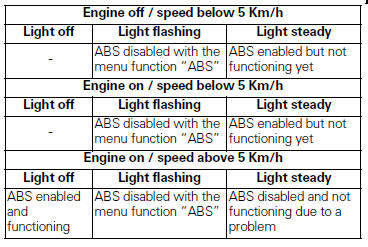
Ducati Diavel Owners Manual: Instrument panel on handlebar
- Lcd.
- Neutral light n (green). Illuminates when the gearbox is in neutral.
- High beam light
 (blue).
(blue).
It turns on to indicate that the high beam lights are on.
- Engine oil pressure light

(red).

Illuminates when engine oil pressure is too low. It must turn on at key-on, but must turn off a few seconds after the engine has started.
It may come on briefly if the engine is very hot, but should go out again as engine speed increases.
 Important
Important
If this light (4) stays on, stop the engine or it may suffer severe damage.
- Fuel warning light
 (amber
(amber
yellow).Comes on when fuel is low and there are about 4 litres of fuel left in the tank.
- Turn indicator lights

(green).Illuminates and flashes when the turn indicator is in operation.
- "Engine/vehicle diagnosis - eobd" light

(amber yellow).
It turns on in the case of "engine" and/or "vehicle" errors and in some cases will lock the engine.
- Limiter light "over rev"/ traction control light "dtc"
(red) (fig. 4):

(*) Depending on the model, each calibration of the engine
control unit may have a different "setting" for the
thresholds that precede the rev limiter and the rev limiter
itself. 
 Note
Note
If the over rev function light and the dtc intervention light should both come on at the same time, the instrument panel gives priority to the over rev function.
- Abs lights
 (amber yellow)
(amber yellow)
(fig. 4).This turns on to indicate that abs is disabled or not Functioning.

 Instrument panel (dashboard)
Instrument panel (dashboard)
The vehicle is equipped with two instrument panels: an lcd
(1, fig. 3) Located on the handlebar containing the key
indications (speed, rpm, coolant temperature and clock) and
a tft colour display ( ...
 Lcd unit functions
Lcd unit functions
Speedometer.
Gives road speed.
Rev counter.
Indicates engine revs per minute.
Clock.
Water temperature indicator.
Indicates engine coolant temperature.
Important
Stop riding i ...
Other materials:
Reassembly of the cylinder head
The exhaust side can be identified by the three threaded holes on the flange.
The intake side can be identified by the presence of four threaded holes on
the flange.
All the photos in this chapter refer to a vertical cylinder head.
Valve guide sealing rings
Position the cylinder head o ...
Lap activation/deactivation function (lap time)
This function activates and deactivates the lap function (lap time).
To access the function it is necessary to view the ""setting" menu", using
buttons (1) "s" or (2) "t" select the "lap"
function and press the reset button (3) to enter the following page.
Function state is highlighted on t ...
Removal of the timing gears
Slide out driving gear (a) of timing gear pair (13) and remove the woodruff
key (14).
Relieve the staking on the lock washer (12) of the nut (11).
Restrain the driven timing gear by inserting a pin in one of the holes, and
unscrew the nut (11).
Remove the nut (11), washer (12) ...